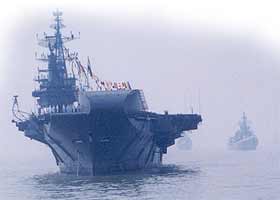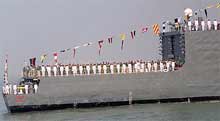Admiral J G Nadkarni (retd)


Admiral J G Nadkarni (retd), chief of the naval staff at the Indian Navy's last fleet review in February 1989, reviews Saturday's International Fleet Review. A rediff.com exclusive
The last coat of paint has been applied and the last bit of brightwork burnished. All ships have arrived and have anchored with precision in their allotted berths in the Naval anchorage.
Thanks to the anti-pollution drive, the unholy mist and early morning smog over Mumbai has
lifted allowing a crystal clear and crisp day to dawn. The drills are over and more than six
months of toil and preparation has now reached the climax.
All the guests including twenty chiefs of foreign navies have arrived in time and are now
seated on the Presidential yacht. We all await the Rashtrapati, Shri K R Narayanan, who as
the supreme commander of India's armed forces has ordered this formal review of his fleet.
More than 89 ships crowd Mumbai's waterway and it's quite a sight. In the distance we can see
the Khanderi and Underi islands where nearly three hundred years ago the intrepid Maratha
admiral, Kanhoji Angre, established himself and had the temerity to impose a tax on every
British merchantman entering Mumbai harbour. The lighthouse on Khanderi has belatedly been
named the Kanhoji Angre lighthouse.
On our way to the Presidential yacht we passed the Bombay naval dockyard, over 270 years old, where a young Nelson's ship had docked at one time. Behind us we can see remnants of the old Bombay Fort, now the Navy's shore headquarters in Mumbai, and preserved as a national heritage monument. The old guns still peep out of their gun ports, no doubt watching history go by. In fact, history overwhelms all of us who are about to watch one more monumental addition to the long list of events and landmarks which have marked Mumbai's progress from a small fishing port to its place as the country's premier port.
 While awaiting the chief guest's arrival we ponder over the enormous effort and planning
which must have been required to mount a show of this magnitude. Nearly ninety ships are in
place in seven rows, not only from the Indian Navy, but also from foreign countries for the
first time. Building bridges of friendship is the theme of the review and indeed the variety and scope of foreign warships makes it clear that the sea transcends all barriers. Ships have
arrived from Iran to Indonesia, from Australia to the United Kingdom and from the USA to Japan.
Thirty heads and senior officers from the navies of the world have accepted the Navy's
invitation.
While awaiting the chief guest's arrival we ponder over the enormous effort and planning
which must have been required to mount a show of this magnitude. Nearly ninety ships are in
place in seven rows, not only from the Indian Navy, but also from foreign countries for the
first time. Building bridges of friendship is the theme of the review and indeed the variety and scope of foreign warships makes it clear that the sea transcends all barriers. Ships have
arrived from Iran to Indonesia, from Australia to the United Kingdom and from the USA to Japan.
Thirty heads and senior officers from the navies of the world have accepted the Navy's
invitation.
On Friday we had the kickoff for the review in the form of a maritime seminar and
saw the unusual sight of the chief of the Iraqi navy sitting next to the C-in-C of the US
Seventh Fleet and a senior officer of the Israeli Navy near the Iranian naval chief. Building
bridges of friendship, certainly.
A flurry of activity. A fanfare. The guard comes to attention anticipating the President's
arrival. Everyone cranes his neck to get a good view. Three of us take out our cameras to take
a picture. The liaison officer frowns and tells us that photography is not allowed. "I will have
to take away your cameras, sir," he threatens. We pull rank and promise to throw him over the
side if he touches our cameras. He goes away.
The guard springs to attention and goes through the precision drill, which they have been
practicing for months. The Supreme Commander acknowledges the salute, says a well done to the
guard commander and boards the ship for the review. The Sukanya, which has been transformed into the Presidential Yacht, casts off and without fuss goes through the manoeuvre which she has practiced endless number of times. All on board, mostly professionals themselves, cluck and admire the fine display of shiphandling. The review commences.
The review mobile column is led by the Sukanya, where the President, now escorted by George Fernandes, the defence minister and Admiral Sushil Kumar, Chief of the Naval Staff, takes
his place on the saluting platform. Escorts stand dutifully by his side. George, who was
supposed to be the keynote speaker at the seminar on Friday, had to cry off at the last minute
due to an emergency Cabinet meeting, is here today and taking obvious pride in the show.
Behind us in the mobile column are two more OPVs with the press and other guests embarked with
a number of smaller craft following them. Two security speed craft manned by commandoes, with
their guns at the ready, crisscross either side. The lead ship heads for the starting point
between the first two columns. The crew of each ship, in immaculate whites, has lined the decks
to cheer the chief guest, all keen that the ceremony goes according to plan. The caps before
the three "Jais" must be doffed at the correct time, not too early, not too late. They must be
held at the correct angle so that the white tops, seen from the yacht, make a good sight.
The three "Jais" must start and end at the correct time, when the President is nearly abreast. Giving them too early will finish them early, leaving an awkward pause while the mobile column passes by. The drill has been rehearsed endlessly. Yet a few ships, nervous perhaps, give the salutation too fast, too early. But they are just a few. Most go through their drill faultlessly.
 The knowledgeable understand the history and drama, which lies beneath. We pass in the same
line the oldest and the newest ship of the Navy. The Viraat is in her 42nd year, the
flagship of the Navy, already 28 years old when the Navy bought her, a veteran of the Falklands
war. Still well preserved after adding another 14 years in the Indian Navy, she leads the line,
like an old dowager at a wedding. Next to her is the Navy's latest and most modern destroyer,
Mumbai, commissioned just a few weeks ago and built with pride by our very own Mazagaon Dock.
The knowledgeable understand the history and drama, which lies beneath. We pass in the same
line the oldest and the newest ship of the Navy. The Viraat is in her 42nd year, the
flagship of the Navy, already 28 years old when the Navy bought her, a veteran of the Falklands
war. Still well preserved after adding another 14 years in the Indian Navy, she leads the line,
like an old dowager at a wedding. Next to her is the Navy's latest and most modern destroyer,
Mumbai, commissioned just a few weeks ago and built with pride by our very own Mazagaon Dock.
Ironies abound. We pass the USS Cowpens, a Ticonderoga class cruiser from the Seventh Fleet. Not many are aware that the same Seventh Fleet intruded into the Bay of Bengal 30 years ago with more menace and less friendship. Times have changed. A country, which did not allow its navy to carry out even simple exercises with foreign navies during the days of non-alignment, today hosts erstwhile members of SEATO and CENTO.
The first line is short and we come to its end quickly. The yacht makes a wide and gracious
sweep and now heads between the third and the fourth lines. In the background the crews of the
ships, which have inspected and have given their cheers, fall out and get below decks, for
their glasses of fresh lime juice.
We pass the Vigilant from Mauritius. She has come more than 3,000 miles across the Indian Ocean to take part. Across is the French nuclear submarine, Perle, the only nuclear propelled vessel on show. She is one of the submarine line, all with only partial black hulls showing above water. The Sindhushastra, India's latest Soviet acquisition, fitted with SSMs is also there.
The column rounds the Tarangini, the Navy's sail training ship, built at Goa, which looks
graceful and lovely in her white paint. The column turns and goes between a line of foreign
warships on one side and Indian built ships on the other. The Indian side has the older Giris, the Coast Guard OPVs in their spotless white, the training ship Tir, the survey vessels and the tank landing craft, Magar.
On the other side the foreign vessels give their cheers as we pass them. We pass Australia, Bangladesh, Japan, Sri Lanka, Iran, Russia, Malaysia, Singapore, South Africa, Thailand, UK and the US. As we come towards the end of this line a mobile column of missile vessels, mostly built in India pass us with impressive speed. It is a thrilling spectacle.
We make a final turn for the last and the most prestigious line. This line is the might of the
Indian Navy. It also quietly underlines its present capability. We pass the Navy's latest
tankers, the Jyoti and the Aditya, which give the Navy its blue-water capability, its mobility and reach. Then follow the three Godavari class destroyers and the Brahmaputra, their latest sister from GRSE, Calcutta. The older Rajput class ships still show power and speed in their sleek lines. Finally come the latest additions and the Navy's pride, the three Delhi class destroyers. They are so big they are more like cruisers.
Behind the sailors manning each ship are the ship's visitors. The visitors have been asked to
come dressed in a particular colour. The Delhi class and the Viraat visitors are dressed in red. They wave tiny national flags at us as we pass.
We come to the end of the line. The President takes the salute of Viraat, the flagship of the Chief of the Naval Staff, which arrived just in time after a major refit. She looks mighty powerful and her sides are spic and span. Along with the sailors on her flight deck is a contingent of jawans who fought in Kargil. Everyone gives a cheer.
The Sukanya heads for the Naval Dockyard. The mist has not fully lifted and we worry if the fly past will take place. But there they are, right on time. A lone Chetak, piloted by the Flag
Officer, Naval Aviation, arrives and salutes the President right on dot. Chetaks, Kamovs and
Sea Kings follow in an impressive display. Fixed wing aircraft come next. Three huge Tu 142
maritime recce aircraft make a lasting impression. Finally arrive the Sea Harriers, give a bomb
burst display, which draws applause from all on board.
As we head towards the berth oohs and aahs fill the air. Right on dot the Sukanya berths at the breakwater and precisely at 1130 the President disembarks. The first International Fleet Review is over. The grand spectacle lingers as spectators make their slow way home.
Design: Uttam Ghosh
Admiral Nadkarni's images of the fleet review
The Complete Coverage | Naval sites
Back to top
Tell us what you think of this special report